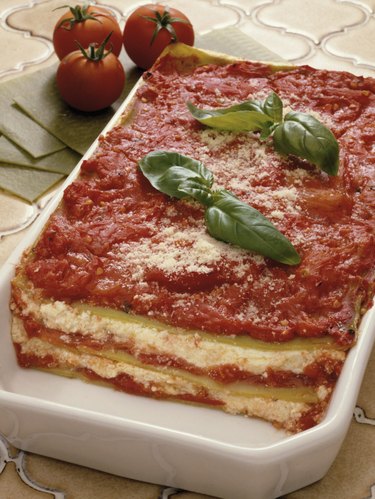
Although making lasagna is a time-consuming project, this traditional pasta dish is always welcome for family dinners or special occasions. To circumvent the time crunch, make and freeze lasagna ahead of time; then cook the dish when you need a quick and delicious homemade meal. Freeze your lasagna in the pan until it's solid, then remove the frozen lasagna from the pan to free up the pan and save freezer space. Wrap the lasagna securely in aluminum foil; and return the frozen lasagna to the freezer. The zesty cheese dish retains its quality in the freezer as long as a month.
Thawing Lasagna
Video of the Day
While it isn't the speediest method, thawing lasagna overnight in the refrigerator is a safe, efficient way to thaw the frozen dinner. If the frozen lasagna is wrapped in plastic or foil, remove the covering and place the lasagna in an oiled baking dish before thawing. Cover the dish with foil and let the lasagna thaw overnight in the refrigerator.
Video of the Day
The Microwave Oven
Use your microwave oven for thawing frozen lasagna if the lasagna is in a microwave-safe container. However, if you thaw lasagna in the microwave, it is critical to cook the lasagna immediately; the microwave may partially cook the lasagna, and bacteria develops rapidly on partially cooked food. Thaw the lasagna on your microwave oven's defrost setting. Allow six to eight minutes for each pound of lasagna. To ensure the lasagna thaws evenly, rotate the pan once during the defrosting time. Although the microwave is convenient for thawing or reheating, lasagna is best when cooked in the oven.
Baking
Once the frozen lasagna is thawed, cook it in an oven preheated to 400 degrees Fahrenheit. Although cooking time depends on the size, a large pan of lasagna generally requires about 1 3/4 hours to cook. Be sure the lasagna is heated completely through before serving. You can also bake a frozen lasagna; however, remember that cooking time for a pan of frozen lasagna is doubled.
Safety
If frozen lasagna has thawed for less than two or three hours, or if the lasagna is still partially frozen and has ice crystals, it is safe to refreeze the lasagna. However, the flavor may be somewhat compromised by partial thawing and freezing. If the lasagna doesn't feel cold, or if the thawed lasagna has been sitting at room temperature for more than two or three hours, you must discard it. Similarly, never let cooked lasagna sit at room temperature for more than two or three hours.